The Soyuz-6/7/8 mission and radio
observations
thereof
Sven Grahn
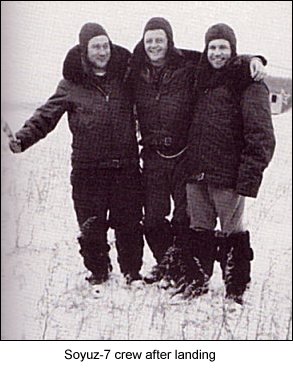
1969
- a pivotal year
After the flight of
Soyuz-4
and -5 the Soviet manned space program was in a somewhat awkward
situation.
The techniques tested in the Soyuz-4/5 mission were applicable to the
manned
lunar landing mission (EVA transfer between two docked vehicles), but
the
docking systems and space suits would be different. According to an
entry
in General Kamanin's (10)
diary for
10 February 1969 TsKBEM (8) plans for
1969
were a week-long solo flight with two cosmonauts followed by a
week-long
docked flight with two spacecraft and five cosmonauts. The leadership
(Ustinov
(6)
and Kerimov (7)) was not satisfied and
demanded
something more solid. Of course, early 1969 was a pivotal period.
Apollo
had just flown around the Moon and a lunar landing was expected in the
summer. The Soviet Union was planning to test its N-1 Moon rocket and
also
to fly its automatic lunar sample returner during the year. The 7K-L1
Zond
was not ready to fly and had been made more or less meaningless by the
flight of Apollo-8. But chances to fly cosmonauts to the Moon were
therefore
practically nil. Therefore something else had to be invented, but the
choices
were not so attractive. There was a distinct requirement to test the
"Kontakt"
docking system for the N1-L3 lunar landing project in earth orbit, but
that may have seemed like a repeat of earlier feats.
Therefore the solo and
docking
flights outlined for 1969 by TsKBEM were combined into a joint flight
of
three spacecraft at a meeting of the Soyuz State Commission 25 April
1969.
The plan was to fly spacecraft 14, 15 and 16 together in August
1969
Spacecraft 15 and 16 would dock and #14 would rendezvous with the
docked
pair and take pictures of it as well as performing a welding
experiment.
A test flight with "Kontakt" docking system was planned for the end of
1969. Kamanin describes the many twists and  turns
of crew selection, but the main event in this process was that the crew
for the active docking ship, Nikolayev and Sevastyanov, did not perform
well enough in docking simulations. It was not until a meeting of the
VPK
(9)
on 18 September that the final crew assignments and planned launch date
was set. The prime crew assignments and choice of radio call signs
(actually
a way of giving the crews the designations A, B and C) were as shown in
the table on right. The crews left for Baikonur on 22 September
expecting
the three launches to take place on 5, 6 and 7 October, but the flights
were delayed by the fact that the Politburo had not yet approved the
mission.
The Politburo decision came on 30 September and on the following day
the
State Commission decided to load the spacecraft with fuel and set the
launch
dates for 11, 12 and 13 october. The launch pads to be used were Area
31,
Area 1 and Area 31 respectively. [This section of this article is based
on the text in (1)]
turns
of crew selection, but the main event in this process was that the crew
for the active docking ship, Nikolayev and Sevastyanov, did not perform
well enough in docking simulations. It was not until a meeting of the
VPK
(9)
on 18 September that the final crew assignments and planned launch date
was set. The prime crew assignments and choice of radio call signs
(actually
a way of giving the crews the designations A, B and C) were as shown in
the table on right. The crews left for Baikonur on 22 September
expecting
the three launches to take place on 5, 6 and 7 October, but the flights
were delayed by the fact that the Politburo had not yet approved the
mission.
The Politburo decision came on 30 September and on the following day
the
State Commission decided to load the spacecraft with fuel and set the
launch
dates for 11, 12 and 13 october. The launch pads to be used were Area
31,
Area 1 and Area 31 respectively. [This section of this article is based
on the text in (1)]
Rumors
in Moscow and the launches commence
On Friday 10 October 1969
UPI
reported from Moscow via Radio Sweden that a mission with three manned
spacecraft was immediately imminent. And, indeed, the following day at
1110.00 UT Soyuz-6 was launched and announced by Soviet media an hour
later
(5).
When Soyuz-7 was launched the following day at 1044.42 UT the rumors
from
Moscow said that the third spacecraft would be manned by veteran
cosmonauts.
The launch was announced by Soviet media 45 minutes after lift-off (5).
While waiting for the launch of Soyuz-8 the Soyuz-7 crew used an
optical
device Svinets (Russian for the metal lead) to try to detect the
hot flames of missiles launched from Soviet territory. Finally, Soyuz-8
left Baikonur at 1019.09 UT on 13 October and Soviet media announced
the
launch at 1055 UT (5). Three spacecraft and
seven
humans were in space simultaneously!

Rendezvous
operations and docking attempts
Available
orbital data
During 14 and 15 October
several attempts to dock Soyuz-8 to Soyuz-7 were made, but it is hard
to
follow these attempts in the rather meager collection of orbital data
available
from US sources. The figure below shows the rather scattered data
points
available. In this graph the initial data or Soyuz-7 have been
discarded
because they seem to be in error.
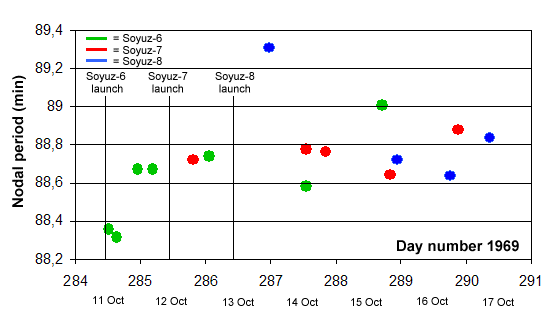 In the figure below I have
tried
to depict the relative position of the spacecraft at the launch of
Soyuz-8
and their relative motion during the following 24 hours. Because of the
lack of good orbital data, I only claim that this picture shows the
overall
situation at the launch of Soyuz-8. Soyuz-8 was ahead of Soyuz-7 and
Soyuz-6
was behind. However, the figure shows Soyuz-6 falling even further
behind,
but I think this is not correct. Probably Soyuz-6 lowered its orbit
slightly
to pull ahead and approach Soyuz-7.
In the figure below I have
tried
to depict the relative position of the spacecraft at the launch of
Soyuz-8
and their relative motion during the following 24 hours. Because of the
lack of good orbital data, I only claim that this picture shows the
overall
situation at the launch of Soyuz-8. Soyuz-8 was ahead of Soyuz-7 and
Soyuz-6
was behind. However, the figure shows Soyuz-6 falling even further
behind,
but I think this is not correct. Probably Soyuz-6 lowered its orbit
slightly
to pull ahead and approach Soyuz-7.
Visual
observation at Kettering, England late on 13 October
In the evening of 13
October
the three craft were observed by Mr. Geoff Perry at Kettering,
England
as they passed over the Midlands. Soyuz-8 was seen passing a particular
constellation in the sky about 45 degrees above the horizon in SSE at
1756:21.4
UT, Soyuz-7 at 1803:13.0 UT and Soyuz-6 at 1804:41.0 UT, all at
magnitude
+0.5 (3). At the same time strong signals
on
shortwaves from the spacecraft were picked up at Kettering. This visual
observation means that the range between Soyuz-8 and Soyuz-7 was about
3200 km, while the range between Soyuz-7 and Soyuz-6 was only 686 km
behind.
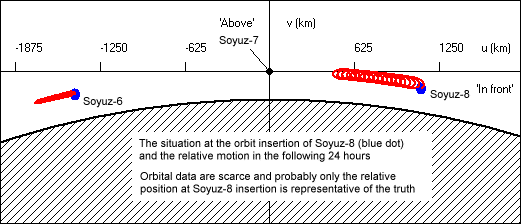
Rendezvous
attempt on 14 October
The original plan was to
let Soyuz-8 dock with Soyuz-7 about 24 hours after the launch of
Soyuz-8,
just like when Soyuz-4 docked with Soyuz-5 in January 1969. Soyuz-7 was
the passive craft and Soyuz-8 the active craft. Orbital maneuvers
calculated
from the ground brought Soyuz-8 to within 1 km of Soyuz-7, but the Igla
automatic rendezvous system failed to provide a "lock-on" between the
two
craft. The two craft drifted away to 3 km distance before mission
control
had decided that the crew of Soyuz-8 could perform the rendezvous
manually
if the range was within 1500 meters. Another try was scheduled for the
following day.
Visual
observation in England late on 14 October
The well known satellite
orbits expert Desmond KIng-Hele at RAE, Farnborough saw two objects "12
km" apart at 1743 UT while Pierre Neirinck also observing from England
saw two object 3.5 degrees of arc apart at the same time (3).
Neirincks observation corresponds to maybe 30 km at a range of 500 km.
However, the execrate location of Neirinck's observation is unknown, so
perhaps the two observations match. Neirinck also saw a third object
one
minute later. If this was Soyuz-6 it was 470 km away.
Rendezvous
attempts on 15 October
The plan was to come
within
1 km at 0600 UT on 15 October, bit it was only at 0940 UT that Soyuz-7
and Soyuz-8 were close enough (1700 m) for a manual attempt at
rendezvous
and docking to be made. But the task, using only the Approach and
Orientation
engines and not the main orbit correction engine, proved too difficult
and the relative velocity was excessive. The two craft passed each
other
at 500 meters range. In the evening the same day Soyuz-6, which did not
carry Igla, was maneuvered to a distance of 800 meters from
Soyuz-7
using a control panel in the orbital module of Soyuz-6. There were
further
maneuvers by Soyuz-8 the following day (orbit 49 & 51) but it is
unclear
if these were connected to additional rendezvous attempts.
CIA's
summary of events - gathered from radio intercepts?
In (11)
there is an interesting summary of the docking attempts.
"... The
five
rendezvous attempts made during the mission were all unsuccessful for
several
different reasons. The first failed because the automatic rendezvous
system
[i.e. Igla] would not indicate radar lock-on between Soyuz 7 and 8. Two
orbits later the first manual rendezvous attempt was made but it was
broken
off after Soyuz 8 used more than the authorized amount of
attitude-control
propellant. A second manual attempt, made the next day, failed because
Soyuz 8 did not properly control its lateral velocity relative to Soyuz
7. The attempt by Soyuz 6 to carry out a cosmonaut-controlled
rendezvous
with the two other spacecraft failed because of insufficient time to
correct
for a three kilometer out-of-plane separation between it and the other
vehicles. The final manual attempt at rendezvous and docking between
Soyuz
7 and 8 was poorly timed and the vehicles could not establish the
correct
interval and relative velocity between them required for docking
operation
before they entered the earth's shadow... "
I cannot escape the
impression
that most of this information was gateherd from air-to-ground voice
intercepted
by monitoring stations in Europe and elsewhere!
The
mission ends
-
Soyuz-6 landed on 16
october
at 0952.47 UT 180 km NW of Karaganda. At 0330 UT a welding attempt had
been made in the depressurized orbital module. When cosmonauts went
back
to the module to fetch samples they saw that the welding device had
almost
burned a hole in the module wall. After retreating for a while to the
descent
module, Kubasov later retrieved the samples.
-
Soyuz-7 landed at
0925.05 UT
on 17 october 155 km NW of Karaganda.
-
Soyuz-8 came down at
0909.58
UT 145 km north of Karaganda.
Telemetry
on shortwaves
Even though TASS did not
announce
any transmission frequencies for this mission much telemetry on
shortwaves
(15.008 MHz and 20.008 MHz) was received by the Kettering
Group (4). Actually signaling on 15.008
MHz
dominated as can be seen from the figure below. No signals at all were
received between 0300 UT and 1000 UT. Most signaling occurred when the
craft were outside the direct visibility from the Soviet Union, which
confirms
the main purpose of this slow speed telemetry link - to provide
rudimentary
status information during the non-visibility period. Of course tracking
ship provided some coverage, but only intermittent.. An exception to
this
general pattern was 15 October 1969, when short-wave signaling was
intense
during passes over the USSR.
Here is what I wrote in
a
letter (2) to Geoff Perry:
... In a
way
signals
on October 13 established a pattern that was to be adhered to during
almost
the rest of the flight. The pattern is: Signals on 20 MHz on the first
orbit of the day which passes Yevpatoria (Crimea tracking site) and
then
again on the southbound transit over the Crimea 4.5 hours later. During
this transit the frequency change to 15 MHz is commanded...
... The reason for
the
frequency change is quite obvious. After about 1700 UT the 20 MHz
frequency
is practically "dead", but 15 MHz keeps "alive" well past midnight. ...
... the time
between first
and last signals on 15 October was 12 hours and 44 minutes which
certainly
is a record for me and shows what the Russians have intended the HF
telemetry
system for. While the spacecraft are out of sight from Soviet tracking
stations and ships while the cosmonauts are sleeping the HF telemetry
link
provides data on the functioning of vital systems on board. The radio
link
with the Soviet Union is never lost, and in case of emergency the HF
frequencies
can also be used for voice transmission. ...
... During the
evening
hours of 14 October there were very long duration transmissions as on
the
13 th. The pattern for these transits are typical of ionospheric wave
guide
propagation; a rather constant signal level after an initial high
level.
...
... On two of the
evening
[16 October] orbits the so-called "antipode effect" could be noticed,
i.e.
when the spacecraft passes the signal strength goes up a bit ...
It was during the
Soyuz6/7/8
mission that the matter of biomedical subcommutation was first
discovered.
This matter is described in detail in the article about Soyuz-4/5.
After
the biomedical subcommutation had been discovered in October 1969, it
was
possible to show, by going back to old recordings, that the same effect
was present during the previous mission in January 1969 and, had we
only
known about it, this characteristic of the telemetry could have been
used
to follow the transfer of two crew members from Soyuz-5 to Soyuz-4.
However, it was in
signals
recorded at about 1800 UT on 13 October 1969 that Geoff Perry at
Kettering
Grammar School discovered a strong variation in the length of telemetry
word 8. He discovered that in the morning of 14 October 1969 while
playing
back the signals recorded the previous evening. Here is what he wrote
in
his diary (3):
"... 14
October
1969 Put Derek's signals from previous night's transit of Soyuz-8 on
pen
[recorder]. Observed variation in length of fourth and eighth words of
frame. Assumed that it might be due to spacecraft tumbling in drifting
mode whilst cosmonauts asleep. ..."
As described in the Soyuz-4/5
article, analysis done in a physics class on 15 October showed that
the change in word-8 was regular, a kind of subcommutation. Signals
received
at Kettering at 1402-1420 UT on that day confirmed the analysis. When
comparing
with signals from Soyuz-4/5 it was obvious that word 8 in the telemetry
frame signaled which cosmonaut was "on-line" for other measurements,
probably
in word 4. Geoff Perry presented these results the following day in a
talk
at a meeting in London of the Institution of Electronic and Radio
Engineers!
(3)
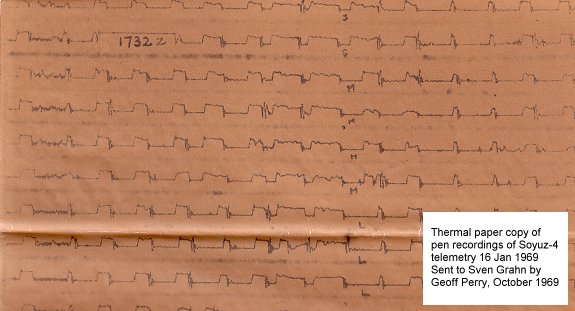
Other
observations
Voice
uplink on shortwaves
During this mission, just
as during previous Soyuz flights, Chris van den Berg in the Netherlands
picked up very clear voice uplink on shortwaves to the crew. This was
probably
intended as a back-up to the VHF link. The messages sent this way
was times for upcoming VHF passes over Soviet ground stations, but also
other data and greetings (listen here
to a greeting from the Baltic Fleet aviation to cosmonaut Shonin) . the
transmitters used were very strong short-wave broadcast stations that
had
a great potential for reaching the spacecraft irrespective of their
location.
When not transmitting instructions the channels was held clear by music
programming and other material. You can read an account of this
fascinating
story here.
Voices
during recovery
I listened intensively on
shortwaves during the morning when Soyuz-8 landed. Everyone was
expecting
a landing since the two other craft were already down. I picked up some
scattered voice signals on 20.008 MHz at 0540 UT, but otherwise there
was
silence. At 0905 UT intense voice activity started on 20.008 MHz with
statements
like "konets polyot, konets polyot" [end of flight!].
This
voice activity continued until 0923. The spacecraft touched down at
0909.58
UT and Radio Moscow announced the successful landing at 0930 UT.
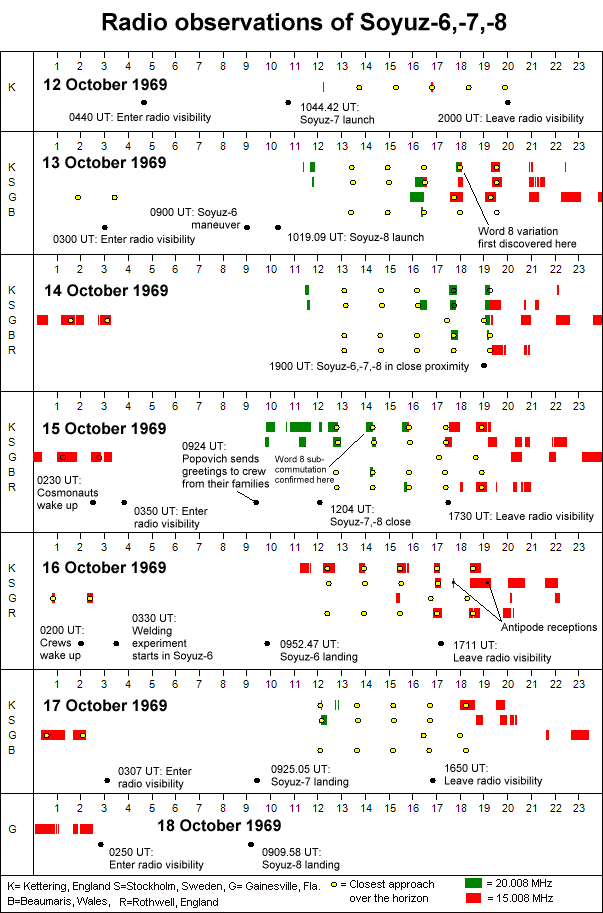
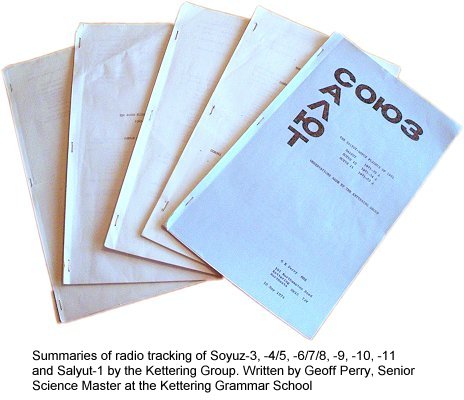
References
and Notes
-
Bart
Hendrickx,
The Kamanin Diaries 1969-171, JBIS, Vol 55 No. 9/10, pp.312-360.
-
Letter
from Sven Grahn to Geoff Perry, 18 October 1969.
-
Perry,
G.E, Day-to-day-log for October 1969. Personal communication to
Sven
Grahn, 1969
-
"The
joint
flight of Soyuz 6, Soyuz 7 and Soyuz 8, 1969-85A, 1969-86A and
1969-87A."
Internal Kettering Group memo written by Geoff Perry and dated 24
February
1970. (See picture above of this and other similar tracking
summaries)
-
Swedish
daily
Svenska Dagbladet, "Fine coverage by Soviet TV", 14 October 1969
-
Ustinov,
Dimitri was the secretary of the Central Committee for defense
and
space 1965-76.
-
Kerimov,
Kerim Aliyevich, the chairman of the State Commission for Soyuz 1966-91.
-
TsKBEM
was the then valid name for Korolev's organization formerly known as
OKB-1,
now known as RKK Energia
-
VPK,
The Military-Industrial
Commission of the Presium of the USSR Council of Ministers. At this
time
its chairman was LV Smirnov.
-
Nikolai
Kamanin was a lieutenant general in the Soviet Air Force and a
well-known
aviator. In 1960 he was appointed to a position where he supervised the
selection, training, and administration of new cosmonauts.
-
Siddiqi,
Asif
A,, "Challenge to Apollo", NASA SP-2000-4408, p.708, citing: US
Centrail
Intelligence Agency, "National Intelligence Estimate 11-1-71: The
Soviet
Space Program." Washington DC, July 1, 1971. p.29

 Back
to Space tracking Notes
Back
to Space tracking Notes
 turns
of crew selection, but the main event in this process was that the crew
for the active docking ship, Nikolayev and Sevastyanov, did not perform
well enough in docking simulations. It was not until a meeting of the
VPK
(9)
on 18 September that the final crew assignments and planned launch date
was set. The prime crew assignments and choice of radio call signs
(actually
a way of giving the crews the designations A, B and C) were as shown in
the table on right. The crews left for Baikonur on 22 September
expecting
the three launches to take place on 5, 6 and 7 October, but the flights
were delayed by the fact that the Politburo had not yet approved the
mission.
The Politburo decision came on 30 September and on the following day
the
State Commission decided to load the spacecraft with fuel and set the
launch
dates for 11, 12 and 13 october. The launch pads to be used were Area
31,
Area 1 and Area 31 respectively. [This section of this article is based
on the text in (1)]
turns
of crew selection, but the main event in this process was that the crew
for the active docking ship, Nikolayev and Sevastyanov, did not perform
well enough in docking simulations. It was not until a meeting of the
VPK
(9)
on 18 September that the final crew assignments and planned launch date
was set. The prime crew assignments and choice of radio call signs
(actually
a way of giving the crews the designations A, B and C) were as shown in
the table on right. The crews left for Baikonur on 22 September
expecting
the three launches to take place on 5, 6 and 7 October, but the flights
were delayed by the fact that the Politburo had not yet approved the
mission.
The Politburo decision came on 30 September and on the following day
the
State Commission decided to load the spacecraft with fuel and set the
launch
dates for 11, 12 and 13 october. The launch pads to be used were Area
31,
Area 1 and Area 31 respectively. [This section of this article is based
on the text in (1)]






